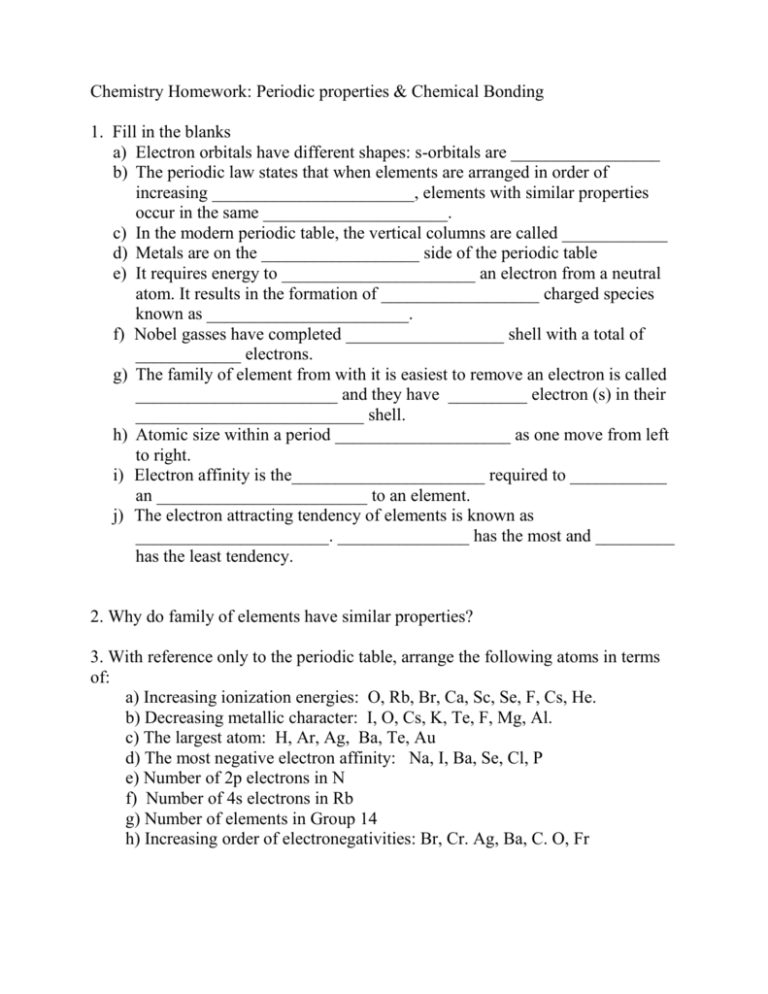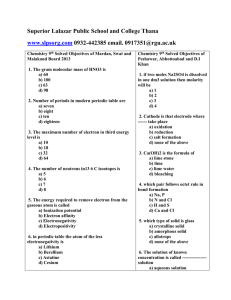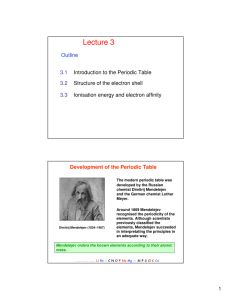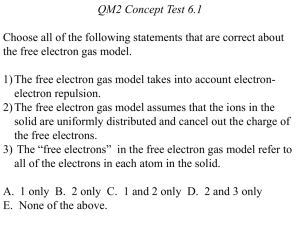Why do family of elements have similar properties
advertisement

Chemistry Homework: Periodic properties & Chemical Bonding 1. Fill in the blanks a) Electron orbitals have different shapes: s-orbitals are _________________ b) The periodic law states that when elements are arranged in order of increasing _______________________, elements with similar properties occur in the same _____________________. c) In the modern periodic table, the vertical columns are called ____________ d) Metals are on the __________________ side of the periodic table e) It requires energy to ______________________ an electron from a neutral atom. It results in the formation of __________________ charged species known as _______________________. f) Nobel gasses have completed __________________ shell with a total of ____________ electrons. g) The family of element from with it is easiest to remove an electron is called _______________________ and they have _________ electron (s) in their __________________________ shell. h) Atomic size within a period ____________________ as one move from left to right. i) Electron affinity is the______________________ required to ___________ an ________________________ to an element. j) The electron attracting tendency of elements is known as ______________________. _______________ has the most and _________ has the least tendency. 2. Why do family of elements have similar properties? 3. With reference only to the periodic table, arrange the following atoms in terms of: a) Increasing ionization energies: O, Rb, Br, Ca, Sc, Se, F, Cs, He. b) Decreasing metallic character: I, O, Cs, K, Te, F, Mg, Al. c) The largest atom: H, Ar, Ag, Ba, Te, Au d) The most negative electron affinity: Na, I, Ba, Se, Cl, P e) Number of 2p electrons in N f) Number of 4s electrons in Rb g) Number of elements in Group 14 h) Increasing order of electronegativities: Br, Cr. Ag, Ba, C. O, Fr 4. a) Provide the element with largest radius: 2+ S , Cl, Cl , K , S b) Provide the element with the largest atomic radius from the following: Be S Na P O c) Provide the element with the largest electronegativity value from the following: Cs Rh Se Ca Mn d) Provide the most metallic element from the following: Ti Br Sn Sr Ag g) Provide the element with the greatest first ionization energy from the following K Li C F O 5. For which of the following pairs of elements would bonding be primarily ionic? a. C and Cl b. Cu and I c. Mg and Cl d. C and S 6. Isoelectric (same electronic configuration) species have the same electron configuration. Which of the following does not belong in the same group of isoelectric species with the others? a. N3- b. F c. Na+ d. Ar 7. Which of the following contributes most directly to the existence of a higher boiling point for H2O than H2S? 8. Which of the following molecules is not linear? (Hint!!! Try to write the Lewis Bond structure first and apply VBEPR) a. BeCl2 b. C2H2 c. SO2 d. BeH2 9. Draw the Lewis Bond structure of the following molecules: a) CCl4 (C is the central atom) b) ONCl (N is the central atom) c) HONO (Atoms arrange H O N O) d) COCl2 ( C is the central atom) e) HCN (C is the central atom) 10. N2 (gas) has exceptionally high bond energy. Predict the number of bonds 2+ in N2 . 11. Which molecule has the most ionic character a. MgS b. HCl c. CO2 d. CaO 12. Which molecule has the greatest polarity? e. Fluorine f. Hydrogen fluoride g. Hydrogen chloride h. Tetrafluoromethane (CF4) 13. When hydrogen bonds with sulfur it makes a gas, when it bonds with oxygen, it makes a liquid. If sulfur and oxygen are in the same family, why are the properties of H2S and H2O so different? 14.State and explain the trend in melting point for the group 1 elements. 15. Predict the shapes and write the proper structural name of the following compounds according to the VSEPR (Valence Shell electron Repulsion) theory. a) CO3-2 b) SiF4 c) PH3 d) SO2











